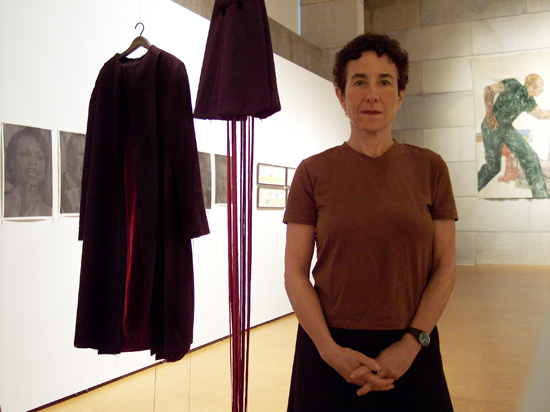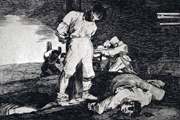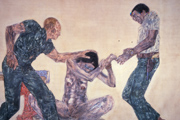War-Time Human Right Abuses Topic of Powerful Zilkha Exhibit
 |
| Nina Felshin, curator of exhibitions and adjunct lecturer in art history, is curator of The Disasters of War: From Goya to Golub, which is on view now in the Ezra and Cecile Zilkha Gallery. |
|
|
| Posted 10/18/05 |
| War, torture and inhumane behavior in the international arena are themes of an exhibit in the Ezra and Cecile Zilkha Gallery.
The Disasters of War: From Goya to Golub features the work of 19 artists that explores human rights abuses in wartime. The exhibition spans five centuries and includes paintings, drawings, videotapes, audio effects, photographs and installations. Nina Felshin, Zilkhas curator of exhibitions and adjunct lecturer in art history, is the exhibits curator. More than 600 people have already viewed the show. Unlike most news images and the dryer forms of communication, aesthetic mediums tend to make the subject matter more accessible through the use of metaphor and by putting a human face or body on it, Felshin explains. The exhibits images include depictions of the dead and injured — some brutally so. Such works as Jacques Callot and Francisco Goyas historical prints are juxtaposed with contemporary images, video testimonies, portraits of powerful individuals and numerous other related subjects. Im not convinced that art, on its own, can lead to social or political change but I am certain it can encourage viewers to ask questions that challenge their long held beliefs, Felshin says, viewing artist Melanie Bakers Writing a Memo (in Blood). Art can be very seductive and draw people in. It can be very powerful. The idea for this exhibition grew out of a project that Felshin worked on in 2002, titled From Goya to Golub, a slide projection for an anti-war concert in Los Angeles, named after Leon Golub and Francisco de Goya. Golub, an American artist who died in 2004, is known for his expressionist paintings of brutality and torture inflicted on prisoners of war. Golubs mural-sized acrylics, Interrogation I, and Interrogation III, which are prominently featured in the exhibition, depict the brutal actions of Central American dictatorships in the early 1980s. In III, a nude, handcuffed woman sits open-legged with two clothed men physically harassing her. Five iconic images from Goyas etching series, The Disasters of War, are also in the Zilkha exhibition. They are on loan from the Davison Art Center. John Paoletti, the Kenan Professor of the Humanities and professor of art history admires the brilliant use of the gallery, especially in the way that the Golub paintings fill up the space and loom so threateningly overhead. Having a wide range of historical responses to war, including the Goya Disasters of War, sets an especially chilling tone to the exhibition, suggesting that as often as the atrocities depicted have occurred, we somehow fail to find ways of working together that would eliminate such horrific actions, he says. In the Sept. 25 New York Times, writer Benjamin Genocchio called the Wesleyan exhibition “probably the most compelling exhibition in the state today.” I do shows like this because I believe that art has the power to raise ones consciousness about important social and political issues, Felshin says. My aim is to put ideas out there in a way that encourages people to question their assumptions and form their own conclusions. Three deeply affecting video works accompany the artwork. Canadian artist Jayce Salloum is represented by a looped DVD projection, untitled part I: everything and nothing, an intimate dialogue with a young woman an ex-Lebanese National resistance fighter who was detained for ten years, six of them in isolation, in the notorious El-Khiam torture and interrogation center in South Lebanon. Felshin says that although anti-war exhibitions are not uncommon at this moment in time, few touch on the torture of human beings and its political significance. There have been lots of anti-war shows out there in the past few years, but this one is about how war affects the human body, and that is what sets it apart from the others, she says. It addresses torture both explicitly and implicitly. One of the inspirations for this exhibition, comments Felshin, is the exhibition that accompanies it in Zilkhas South Gallery titled Inconvenient Evidence: Iraqi Prison Photographs from Abu Ghraib. Curated by Brian Wallis and co-organized by the International Center of Photography in New York and The Andy Warhol Museum in Pittsburgh, this exhibition includes photographs from Abu Ghraib. Included are photos of recent newsmaker Pfc. Lynndie England posing and smiling with abused detainees. Felshin, who held a gallery reception Sept. 9, wants this powerful exhibition to elicit reactions. I still get goose bumps when I come in here, she says. The Disasters of War: From Goya to Golub is open noon to 4 p.m. Tuesday through Sunday in the Ezra and Cecile Zilkha Gallery and runs until Dec. 11. Admission is free. For more information call 860-685-3355. |
| By Olivia Drake, Wesleyan Connection editor |




 From left to right, Melanie Baker’s charcoal and pastel drawing, Writing a Memo (in Blood); Francisco de Goya’s etching from The Disasters of War (Los Desastres de la Guerra) and Leon Golub’s acrylic on canvas, Interrogation III, on loan from The Broad Art Foundation, Santa Monica.
From left to right, Melanie Baker’s charcoal and pastel drawing, Writing a Memo (in Blood); Francisco de Goya’s etching from The Disasters of War (Los Desastres de la Guerra) and Leon Golub’s acrylic on canvas, Interrogation III, on loan from The Broad Art Foundation, Santa Monica.